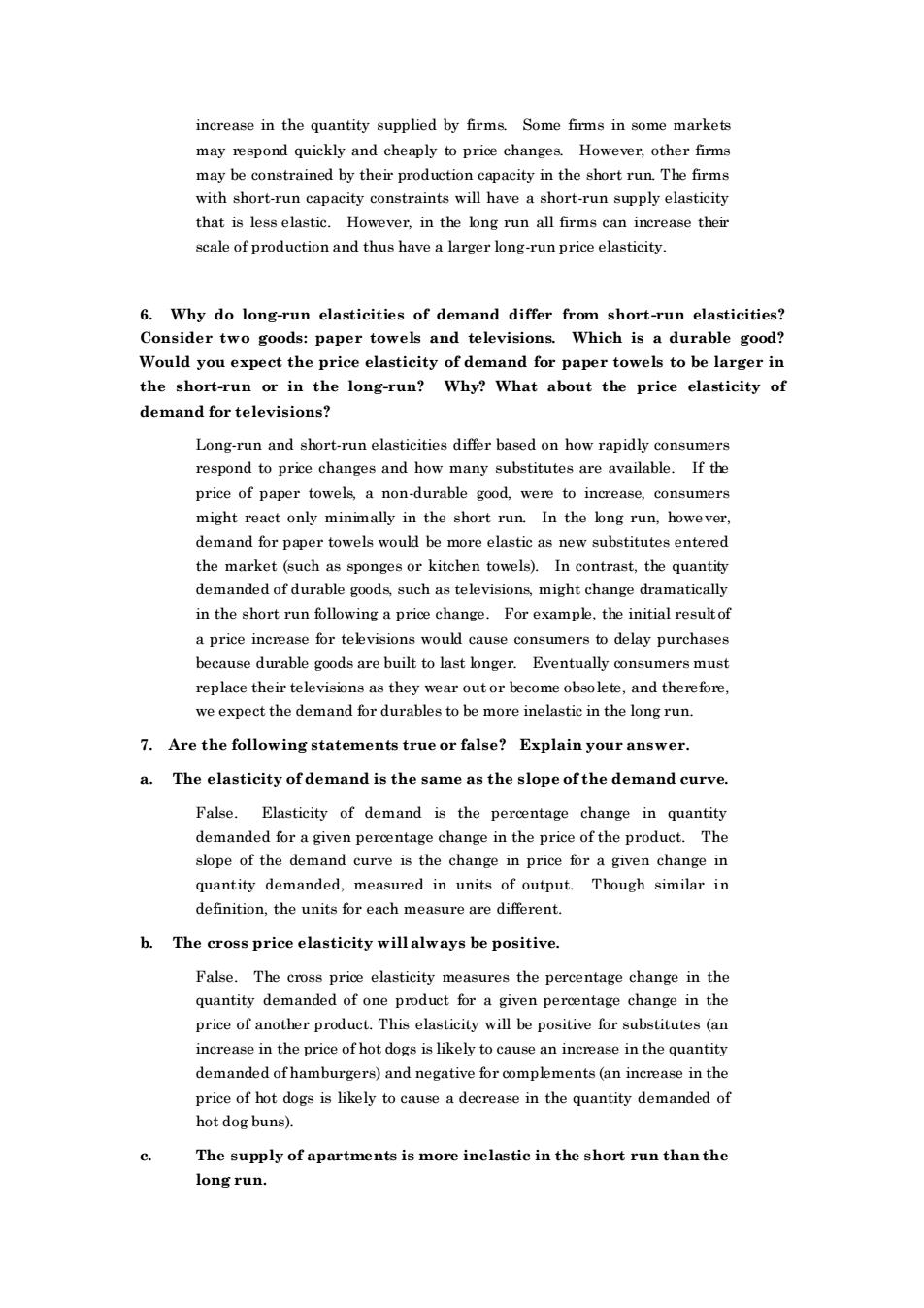正在加载图片...

increase in the quantity supplied by firms some firms in some markets may respond quickly and cheaply to price changes However,other firme may be constrained by their production capacity in the short run.The firms with short-run capacity constraints will have a short-run supply elasticity that is less elastic.However,in the long run all firms can increase their scale of production and thus have a larger long-run price elasticity. 6.Why do long-un elasticities of demand difhcaticitie two g wes and televisio able good? t pcctcty of de or ods the short-run or in the long-run?Why?What about the price elasticity of demand for televisions? Long-run and short-run elasticities differ based on how rapidly consumers respond to price changes and how many substitutes are available.If the price of paper towea non-durable to might react only minimally in the short run.In the lng run.bowever demand for paper towels would be more elastic as new substitutes entered the market (such as sponges or kitchen towels).In contrast,the quantity demanded of durable goods such as televisions,might change dramatically in the short run following a price change.For exampk,the initial result of a price increa se for televisions woul cause consumers to delay purchase because durable goods are built to last longer.Eventually consumers must replace their televisions as they wear out or become obsolete,and therefore, we expect the demand for durables to be more inelastic in the long run. 7.Are the following statements true or false?Explain your answer. a.The elasticity of demand is the same as the slope of the demand curve. False.Elasticity of demand is the percentage change in quantity demanded for a given pere change in the price of the produet.Th slope of the demand curve the change in change in quantity demanded,measured in units of output Though similar in definition,the units for each measure are different. b.The cross price elasticity willalways be positive. False.The cross price elasticity measures the percentage change in the quantity demanded of one product for a given percentage change in the se in the price of hot dogs is likely in the quantit demanded of hamburgers)and negative for complments(an increase in the price of hot dogs is likely to cause a decrease in the quantity demanded of hot dog buns). c The supply of apartments is more inelastic in the short run than the long run.increase in the quantity supplied by firms. Some firms in some markets may respond quickly and cheaply to price changes. However, other firms may be constrained by their production capacity in the short run. The firms with short-run capacity constraints will have a short-run supply elasticity that is less elastic. However, in the long run all firms can increase their scale of production and thus have a larger long-run price elasticity. 6. Why do long-run elasticities of demand differ from short-run elasticities? Consider two goods: paper towels and televisions. Which is a durable good? Would you expect the price elasticity of demand for paper towels to be larger in the short-run or in the long-run? Why? What about the price elasticity of demand for televisions? Long-run and short-run elasticities differ based on how rapidly consumers respond to price changes and how many substitutes are available. If the price of paper towels, a non-durable good, were to increase, consumers might react only minimally in the short run. In the long run, however, demand for paper towels would be more elastic as new substitutes entered the market (such as sponges or kitchen towels). In contrast, the quantity demanded of durable goods, such as televisions, might change dramatically in the short run following a price change. For example, the initial result of a price increase for televisions would cause consumers to delay purchases because durable goods are built to last longer. Eventually consumers must replace their televisions as they wear out or become obsolete, and therefore, we expect the demand for durables to be more inelastic in the long run. 7. Are the following statements true or false? Explain your answer. a. The elasticity of demand is the same as the slope of the demand curve. False. Elasticity of demand is the percentage change in quantity demanded for a given percentage change in the price of the product. The slope of the demand curve is the change in price for a given change in quantity demanded, measured in units of output. Though similar in definition, the units for each measure are different. b. The cross price elasticity will always be positive. False. The cross price elasticity measures the percentage change in the quantity demanded of one product for a given percentage change in the price of another product. This elasticity will be positive for substitutes (an increase in the price of hot dogs is likely to cause an increase in the quantity demanded of hamburgers) and negative for complements (an increase in the price of hot dogs is likely to cause a decrease in the quantity demanded of hot dog buns). c. The supply of apartments is more inelastic in the short run than the long run